When used the right way, humor can help you stand out from the crowd, relate with your audience, make them laugh, gain their trust, and ultimately create a deeper connection with them.
However, it can be tough to write funny emails because, as a writer, you would not be able to gauge what your audience's reaction would be like. And that's why using humor can be tricky.
If you use the wrong joke for the wrong audience, you'll only end up confusing or, worse, offending your subscribers.
For example, if you're a marketer, then you will get this joke:
Q: Why do content marketers constantly feel cold?
A: They're surrounded by drafts.
But, if you send out this joke to everyone in your email list that includes people who are not marketers, they will not get it.
So, to assist you, we have written this article to guide you on how to create funny emails and when it is appropriate, along with some funny email examples.
Table of contents
- Why should you send funny emails in the first place?
- When can you use humor in emails?
- When not to use humor in email marketing?
- How to use humor in marketing and create funny emails?
- Go on, create your funny emails today.
Why should you send funny emails in the first place?
Humor in the email's subject line can help you stand out from the crowd and entice people to open your emails.
And, with a funny email copy, you can showcase your personality through your emails, connect with users, and if you make it personalized, it can help increase your email conversion rates.
Humor also differentiates you from other brands, making your subscribers curious to know more about you and anticipate your following email.
When can you use humor in emails?
As with everything else, there is a time and place for funny emails because it is not appropriate in all circumstances. Here are certain types of emails where the use of humor would be well received:
• Welcome emails
Welcome emails have always been generic like "Hey Joe, welcome to our company," but you can make it so much more by injecting a bit of humor and personality.
Here's how GFDA has injected their brand's personality and quirky humor into their welcome emails.
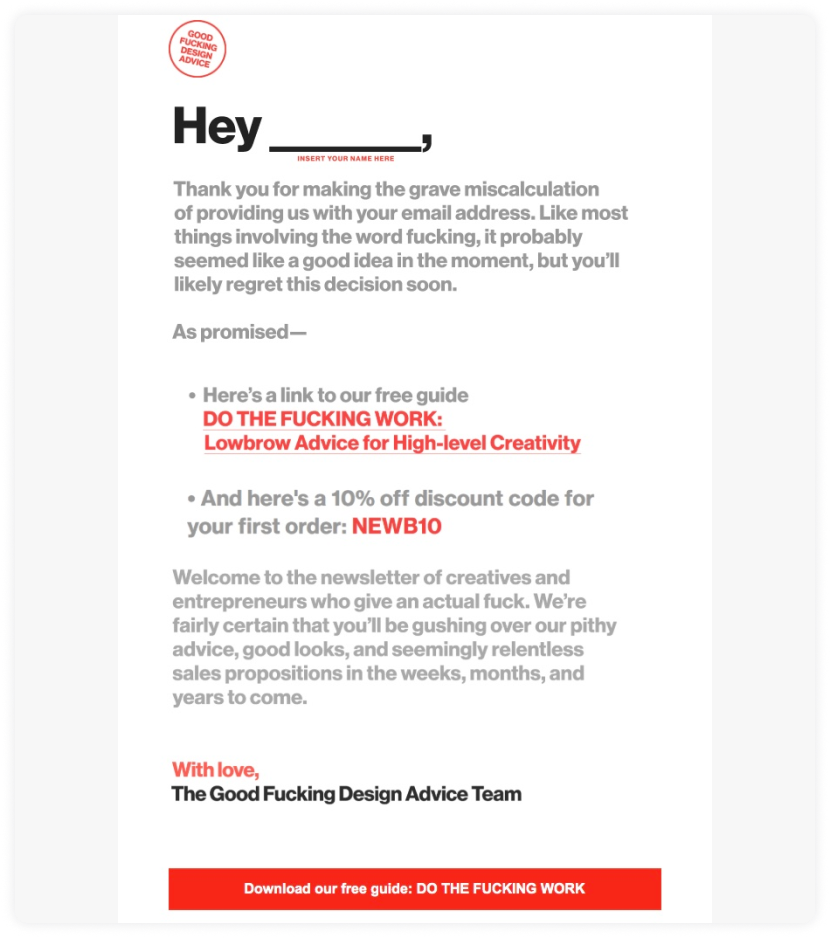
Source: Really good emails
• Cold emails
Marketers send cold emails to advertise their products to people who might benefit from them and gain high-quality leads. And, most of the time, you might not get noticed by people so, create funny cold emails to pop out in your subscriber's inbox.
• Abandoned cart emails
Most small businesses or eCommerce find it awkward to send people emails to remind them that they have left something in their cart. So, you can use humor in abandoned cart emails to ease the awkwardness and even use AMP for emails to make the checkout process seamless for your subscribers.
Here, Rudy's Barbershop has tried something unique, funny, and different from the usual" Your cart misses you."
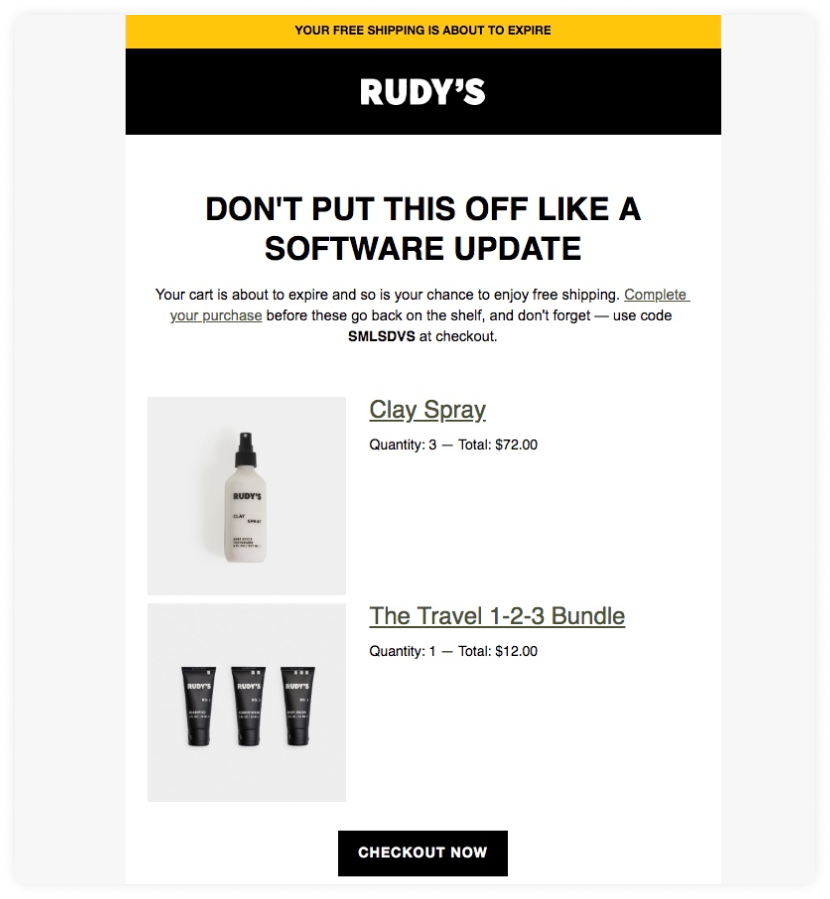
Source: Really good emails
• Onboarding emails
The welcome email is for anyone who joined an email list, but an onboarding email is sent to users who have just started to use your service. A funny onboarding email can make a good impression and make you seem approachable to the user, so they won't hesitate to contact you if they have any doubts or problems.
• Newsletters
Newsletters are becoming increasingly popular, and many brands have started experimenting and finding out how to take it up a notch.
You can zhuzh up your newsletter by playing around with the layout, using fun images, and making the copy or subject line of the email funny.
• Promotional emails
Companies have always experimented with promotional emails to change content, CTA, and layout because it's hard to get people hooked enough to convert into customers. However, you can change how you promote and focus on being different by capturing their attention with funny emails.
Here, Who gives a crap first captures your attention with their name and then with their subject line: It's pronounced "craptcha," and the content of the email itself.
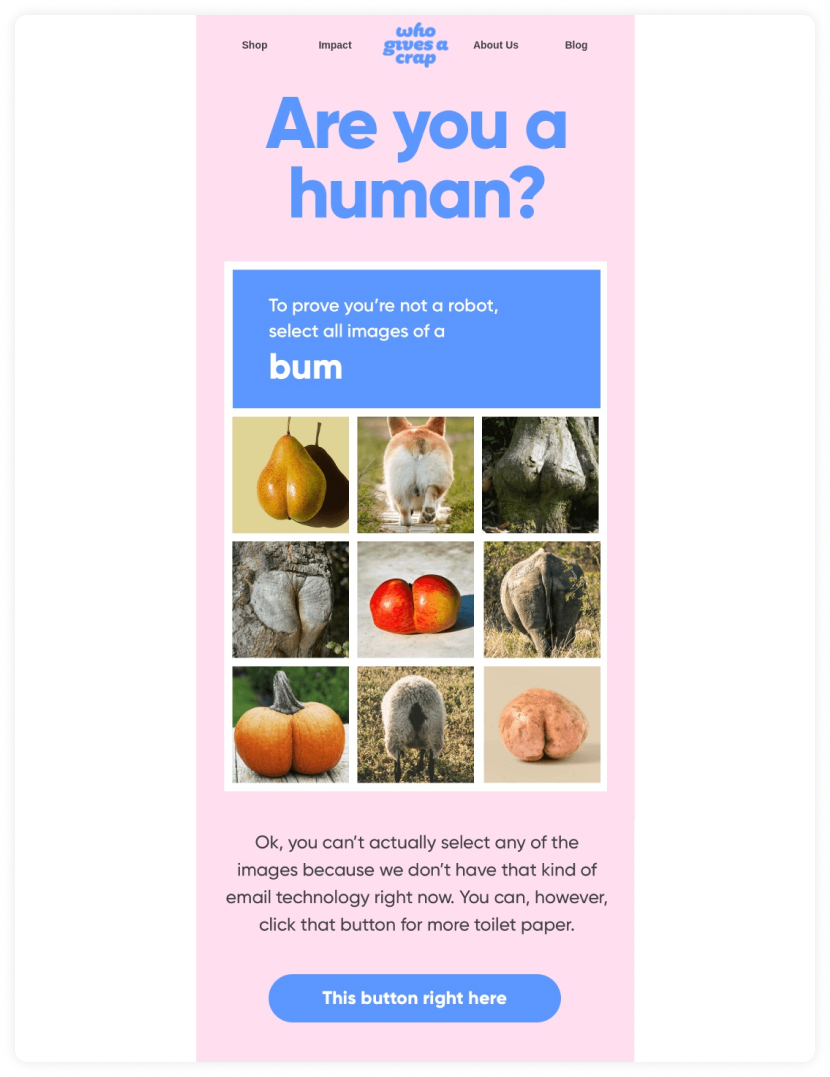
Source: Really Good Emails
When not to use humor in email marketing?
While it's okay to be quirky and fun, there are times when you have to get serious provide solutions instead of humorous responses.
Here are some circumstances where it is best to avoid using humor in the email:
When you send customer service emails.
Transactional emails like shipping information, receipts, password resets, etc.
Emails delivering sensitive news like a price increase or somber holidays
In these situations, your subscribers want emails that are to the point, honest and serious. Because when a customer is frustrated, they don't want to laugh, they require you to take their problem seriously and provide solutions.
There are many cases where humor can be worth the risk, and it's up to you to decide whether you want to take it or not.
If you are apprehensive, we advise you to start small with a few jokes or puns in your subject line or copy, see how your audience reacts, and slowly move on to full-on funny emails.
Tip: Don't dabble with political jokes unless it's appropriate for your context, but it's best to stay away from it. Stick to using animals or cute stuff if you are a beginner, as it's a safe way to dabble with humor. And also, don't be that exclusive smartass who finds a creative reference that only 0.001% of the population will get.
How to use humor in marketing and create funny emails?
You know when you should and shouldn't send funny emails but wonder how to create funny emails. Here are some of the different ways to add humor and create funny emails:
1. Wordplay and puns
Yes, cliché, but we can't deny that a good pun or wordplay can be hilarious. We might scoff at them but secretly enjoy the 'dad joke' type of humor.
You can create puns that work with your products or services as it is a foolproof way to showcase your personality and lighten up your subscriber's day, like how Poo~Pourri does in the example below.
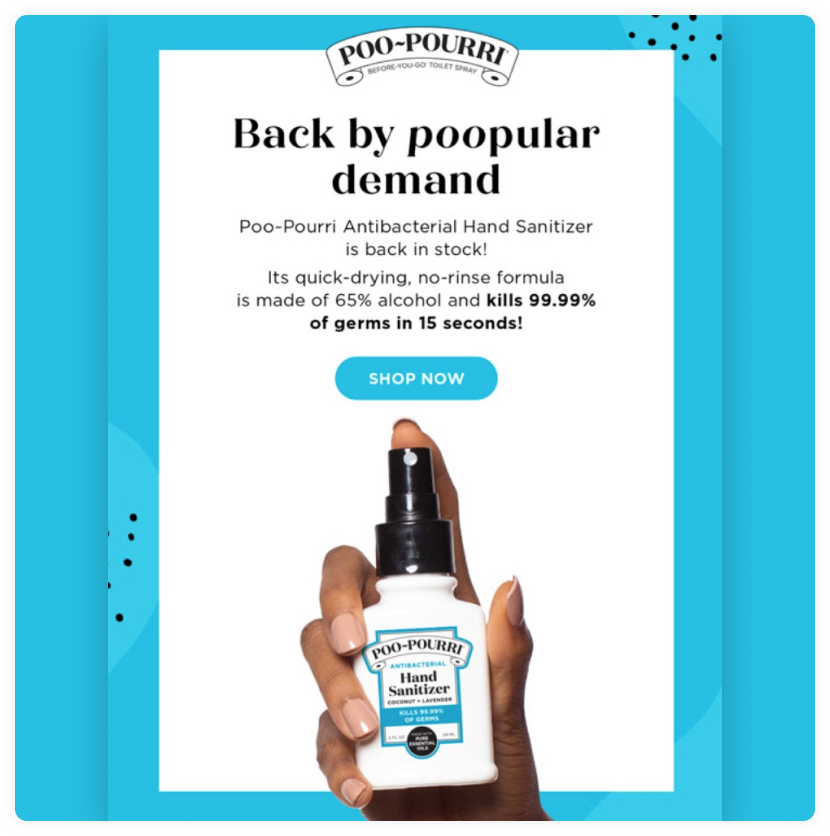
Source: Sleeknote
They are an online retailer selling toilet sprays to combat foul toilet odors. And, from their company's name, we can gather that they are not opposed to good wordplay.
We can see the quirky use of humor through wordplay in their email above advertising a product back in stock because of "poopular" demand.
2. Use a relatable situation
Think about your customers, what they face daily, and create a funny email that acknowledges their problems and solves them.
You can use the following steps when creating funny email content relevant to your subscribers:
Know your audience well
Understand your prospects' pain points
Address to those pain points
Describe how your service or product can solve their problems
Add a touch of humor when providing them solutions for their problems.
Here is an email created by the 8 am creative where they provide a gifting guide for what to give to people you hate. If that's not genius, I don't know what is.
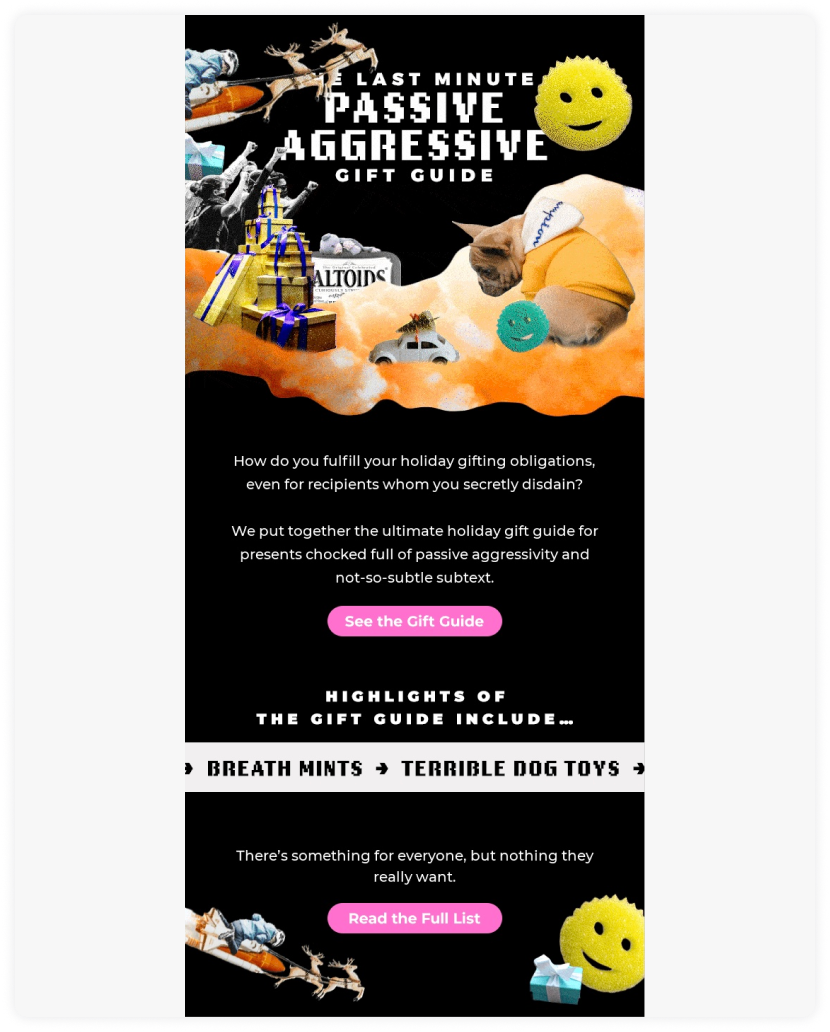
Source: Really good emails
3. Self-deprecation
A subscriber is more likely to find you approachable and trustworthy when they see that you are willing to make fun of yourself.
But, don't go overboard with it because they will think you don't take yourself seriously.
One of the few times you can use self-deprecating humor is when you send an acknowledgment email to address an oopsie you had made in an email you have sent out.
Who Gives A Crap had sent out an apology email for sending an email that was supposed to be sent that week. And the funny part was their excuse, which was "Our copywriter had a baby."
4. Use image, copy, and CTA together to make it funny
If you already incorporate humor into your subject line and copy, use the image, copy, and CTA cohesively to take it up a notch.
In the example below, Fossil has made the entire email theme based on feline cats to showcase their popular collection" The Tiger King" with a creative CTA" Pounce" instead of the usual shop now.
Subject: You Say "Tiger," We Say... 👑👀

Source: Really good emails
5. Use what's trending or happening in the world
Stay informed on what's happening in the world and create content around it at the right time.
Shinesty is an apparel brand known for its sarcastic voice and branding. Here's how they have used what's happening in the world to create funny emails relevant to their customers.
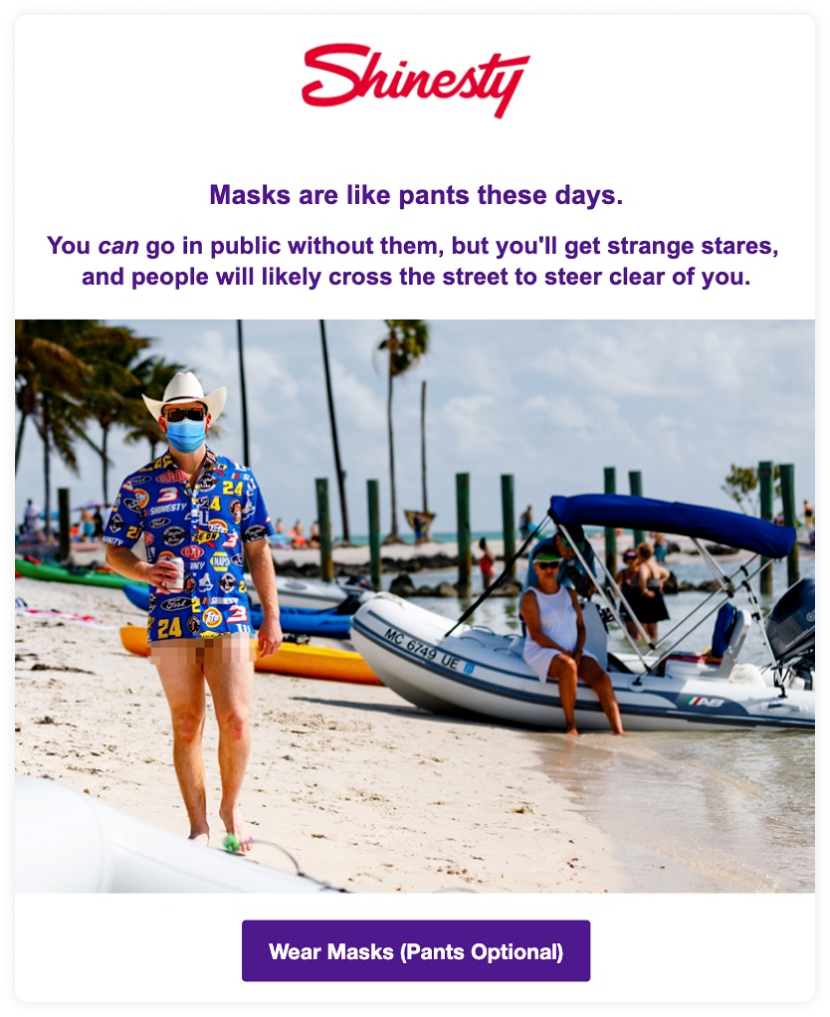
Source: Sleeknote
Their subject line was "pants are optional" and have funnily described in the email how pants may be optional in Corona, but masks are not.
6. Subtle humor
Now, if you are not ready to dive in like Shinesty, you can use a couple of dad jokes and subtle humor instead.
Quip is a dental health care subscription company that has used such subtle humor in its newsletters.
The subject line was "Happy String Cleaning (Sorry, we had to!)".
They make you giggle with the funny email subject line while keeping it relevant for its niche.
They are playful, subtle, and use feel-good humor, which you can also try to put if you are unsure about bold and risky humor.
Go on, create your funny emails today.
Jazz up your dull, corporate communication style and bring your emails to life using humor.
When adding humor, we recommend you incorporate GIFs and emojis as they pair well with your jokes like wine and cheese.
Stay on the safe side, don't make jokes on controversial stuff and at the wrong times, and you will be good to go. Now shoo, go on and make your emails funny.

